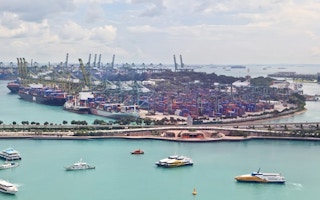The cargo vessels that carry 80 per cent of the world’s trade and the cruise ships that take thousands of passengers to pristine tourist attractions use the world’s dirtiest fuel.
With 60 per cent of the world’s ports already voluntarily excluding the worst-polluting ships, owners are in a desperate hunt to find ways to clean up their act – and a giant steel sponge could be the answer.
Technology used in a pilot project developed by Carlos Dorao and Maria Fernandino, researchers at the Norwegian University of Science and Technology (NTNU), was originally designed for the gas industry, where gas being pumped out of a well has to be separated from the liquid.
Separators are expensive and bulky, but the two researchers’ invention – a large spinning steel sponge that is half the size of a typical separator – does an effective job.
Left-over sludge
Around 60,000 large ships use bunker fuel, which is the sludge left over from crude oil after it is refined for petrol, diesel and other petroleum products. The fuel is 50 times more polluting than fuel permitted in diesel cars.
These ships’ giant engines also produce nearly 3 per cent of the world’s carbon dioxide emissions − more than the total from all of the world’s aircraft.
The International Maritime Organisation has introduced new rules to force the introduction of cleaner engines by 2020. But both the European Union and the US have produced tighter rules that will take effect before then − in effect banning the worst ships from their shores.
The levels of emissions of particulate matter, sulphur dioxide and heavy metals will all have to be cut, and engines will need to be more energy-efficient to reduce greenhouse gases.
The new clean-up technology was originally designed for the gas industry, where the gas being pumped out of a well has to be separated from the liquid.
Separators are expensive and bulky, but the two researchers’ invention – a large spinning steel sponge that is half the size of a typical separator – does an effective job.
The NTNU’s sponge catches the water as it flows through the gas well, and the spinning effect throws the water out sideways and downwards, while allowing the gas to flow upwards through the sponge.
Statoil, the Norway-based energy multinational, has now taken on the technology and is developing it to replace traditional separators in the natural gas industry.
This novel solution is the Lynx Separator, and a company called InnSep was created in 2011 to develop and market the idea.
Removing pollutants
Now the Research Council of Norway’s Innovation Programme for Maritime Activities and Offshore Operations (MAROFF) is funding a pilot project that examined the possibility of applying the technology to cleaning the exhaust emissions from ships.
The project mixed seawater with exhaust fumes to see whether the spinning sponge had the same effect on removing pollutants, including sulphur particles. It worked.
The next step is for InnSep to take the pilot project results to the shipping industry and work out the fastest and cheapest ways to integrate the technology into ships’ engines.
Sondre Jacobsen, InnSep’s chief executive, says that with the shipbuilding industry now facing such stringent emission standards, this field appears a very promising business opportunity for the new separation technique.










